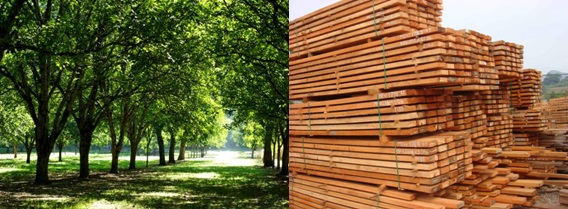Timber vs wood
There is often confusion about the interchangeability of the terms ‘timber’ and ‘wood’.
The term ‘wood’ is used to refer to the substance that makes up the tree. It is the hard, fibrous structural tissue that is commonly found in the stems and roots of trees. The primary function of wood is to support the tree, enabling it to grow straight and tall enough to be able to absorb sunlight for photosynthesis. Wood also enables the transfer of water and nutrients to growing tissues and leaves.
The term ‘timber’ is used to refer to the wood at any stage after the tree has been felled. This can include the raw material, also known as rough timber or the processed material.
In the UK, Australia and New Zealand, as well as some other countries, timber typically refers to sawn wood products that will be used in construction, such as floorboards. 'Timbers' may refer specifically to timber beams or boards used in house building.
In the United States and Canada, timber often refers to felled trees, and the term ‘lumber’ is used to refer to sawn wood products.
What begins with timber in its most basic form can these days result in the most advanced of products.
From the versatility of plywood, the creation of massive glulam beams or even beautifully crafted veneer, engineered wood products provide a varied range of materials that use timber for an increasing list of both structural, functional and design applications.
These products are not only helping to redefine modern construction practices, but show that wood can rival more traditional building products in terms of its environmental impact, strength, cost, finish and workability.
NB See: The use of wood in construction for an alternative definition.
[edit] Related articles on Designing Buildings
- 11 things you didn't know about wood.
- Carpentry.
- Definition of tree for planning purposes.
- Forests.
- Physical Properties of Wood.
- Predicting service life of timber structures.
- Sapwood.
- The differences between hardwood and softwood.
- Timber.
- Tree rights.
- Types of timber.
- Wood around the world.
- Wrot timber.
Featured articles and news
Latest Build UK Building Safety Regime explainer published
Key elements in one short, now updated document.
UKGBC launch the UK Climate Resilience Roadmap
First guidance of its kind on direct climate impacts for the built environment and how it can adapt.
CLC Health, Safety and Wellbeing Strategy 2025
Launched by the Minister for Industry to look at fatalities on site, improving mental health and other issues.
One of the most impressive Victorian architects. Book review.
Common Assessment Standard now with building safety
New CAS update now includes mandatory building safety questions.
RTPI leader to become new CIOB Chief Executive Officer
Dr Victoria Hills MRTPI, FICE to take over after Caroline Gumble’s departure.
Social and affordable housing, a long term plan for delivery
The “Delivering a Decade of Renewal for Social and Affordable Housing” strategy sets out future path.
A change to adoptive architecture
Effects of global weather warming on architectural detailing, material choice and human interaction.
The proposed publicly owned and backed subsidiary of Homes England, to facilitate new homes.
How big is the problem and what can we do to mitigate the effects?
Overheating guidance and tools for building designers
A number of cool guides to help with the heat.
The UK's Modern Industrial Strategy: A 10 year plan
Previous consultation criticism, current key elements and general support with some persisting reservations.
Building Safety Regulator reforms
New roles, new staff and a new fast track service pave the way for a single construction regulator.
Architectural Technologist CPDs and Communications
CIAT CPD… and how you can do it!
Cooling centres and cool spaces
Managing extreme heat in cities by directing the public to places for heat stress relief and water sources.
Winter gardens: A brief history and warm variations
Extending the season with glass in different forms and terms.
Restoring Great Yarmouth's Winter Gardens
Transforming one of the least sustainable constructions imaginable.
























Comments